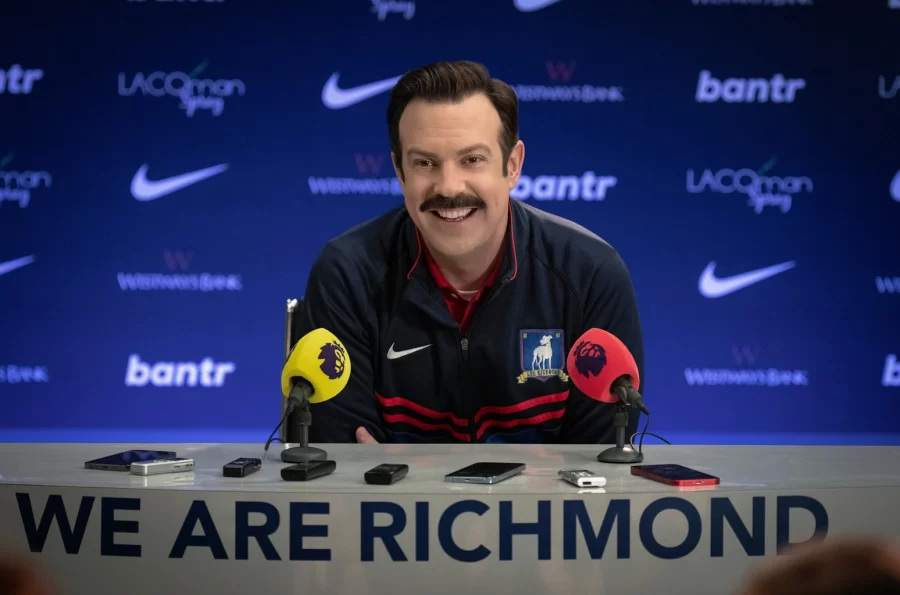In the Ted Lasso franchise, Season 3 is a keeper
A dive into the first two episodes of the third and possibly final season of Ted Lasso proves the show is still undeniably funny but will also teach its audience much needed life lessons.
From the depths of reusable masks and social distancing, people found comfort in an unlikely place: the corny jokes of an American coaching British Premier League soccer. When the show premiered in 2020 on Apple TV+, Ted Lasso (Jason Sudaikis) began his mission of coaching the AFC Richmond Greyhounds with virtually no knowledge of soccer. Whether it’s because of his iconic mustache or positive methods of motivation, Ted has captured the audience’s attention and taken them on a roller coaster journey of emotion. With the first two episodes of the third season recently released, fans can still rely on the show for a laugh, but also for meaningful messages about life.
In the first episode, a bittersweet goodbye after a visit from his son Henry has left Ted alone and unsure of the necessity of his coaching role at Richmond. Although they have been moved back up to the Premier Leagues, every prognosticator has predicted Richmond to come in last. One of the skeptics includes former Richmond coach Nate Shelly (Nick Mohammed), who has now been named manager of West Ham United. The tension between the former coach and Ted continues in this season which isevident in the snarky comments made by Nate in a press conference. The Richmond team is feeling the pressure, including club owner Rebecca (Hannah Waddingham), who urges Ted to fire back in response to Nate’s criticism. Various other stressors weigh on the cheery Ted Lasso vibe, like the rocky status of Roy (Brett Goldstein) and Keeley’s (Juno Temple) relationship and the opposition against journalist Trent Crimm’s involvement with the team. This introduction seems night and day to the positive message the show usually conveys, but as the characters continue to learn the “Lasso” way, they will likely respond to these hardships with humor and understanding as the season continues.
When the show first aired, viewers latched onto the charismatic characters in times of uncertainty, but as the world healed, Ted Lasso started to head down a more realistic path. While the purely positive vibes worked in the first season, I think the writers have made a smart and necessary choice to start exploring the darker backstories of the characters. The first episode in the new season gives the audience a look at the loneliness and uncertainty Ted is experiencing through his conversation with therapist Dr. Sharon, and shows us that, yes, Ted is cheerful, but just like us, he’s still human. Another character arc this season focuses on is Roy and the backstory behind his lessened but still prevalent gruff demeanor. Roy’s resentment towards Trent Crimm working with the team ultimately leads to a discussion of the former football star’s beginnings. This allows the audience to see a more vulnerable side of Roy, and learn some of the possible reasoning behind his aggressive personality. This season provides conversations of serious topics mixed into the jokes, and viewers can see a more genuine side of the characters. Even though the comedic moments are becoming slightly less frequent, they have a more natural place in the conversations and feel more realistic when they do occur. Especially since one of the biggest complaints of the first few seasons was how unrealistically happy the plot is, I think this change will keep the show relevant in the long run.
While I can see how allocating more screen time to further explore the characters’ backstories has had a positive impact on the show, it does cause one issue. Now that everyone has their own storyline and their own personal business, there are an increased number of episodes and longer run times to cover all the individual plots. I saw this in the first episode as the show jumped around from person to person to explain all the various side plots and catch new viewers up to speed. Though once the show got over this hurdle in the second episode, it already felt less cumbersome to watch with more screen time spent on the comedy. Seeing the show’s evolution up to this season, I have enjoyed watching the plot veer away from the original story and seeing the characters become more realistic and relatable, but new Lasso fans may have been less inclined to continue.
While fans enjoy the hopeful messages covered in Ted Lasso, the show excels because of the actors’ memorable deliveries of writing that is already so well crafted. The group has such strong chemistry and the funniest moments come from the multi-character interactions, like the witty exchanges between Ted and the Richmond staff that he’s dubbed the “Diamond Dogs” as well as the camaraderie of the Richmond team. One of the funniest performances comes from Jamie Tartt (Phil Dunster), who has evolved over the show to become a team player but still has enough of his “Jamie” wit to keep the show hilarious. Ted takes the team on an unconventional field trip down to the sewers to teach them a lesson on letting negativity go. Jamie reciprocates this lesson by reminding his fellow players that the comments made by the sports prognosticator are just “poop-eh” and the team should “let it flow”. He keeps the coaching staff in check with surprisingly insightful comments and supports his teammates with an addictive mix of understanding and classic Jamie snarkiness.
The advice given in the show says it best: Keeley reminds Rebecca that the team will be the most successful if she can “let Ted be Ted”, and I think fans who listen to that guidance when watching will end up enjoying the show. If you let Ted Lasso be what it’s trying to be—a heartwarming story of characters that support each other throughout their very real struggles (and many corny dad jokes)—audiences will find that this season is a success.
jy/ew
For more breaking news and photos, follow The Wingspan on Instagram and Twitter @CHSWingspan.




